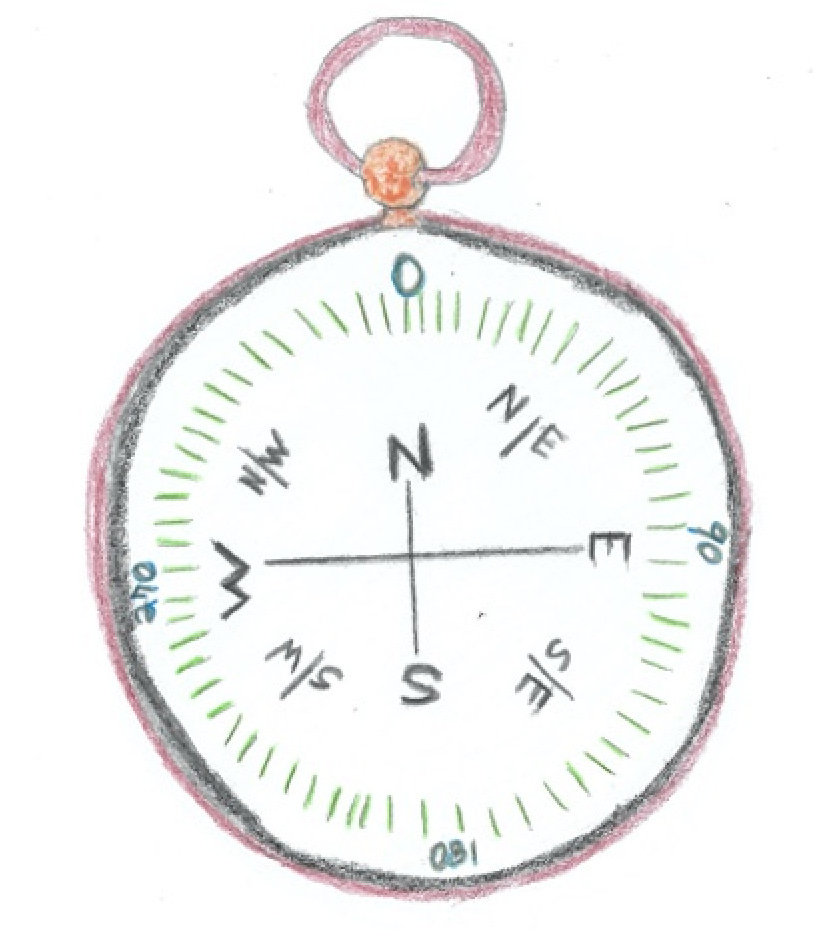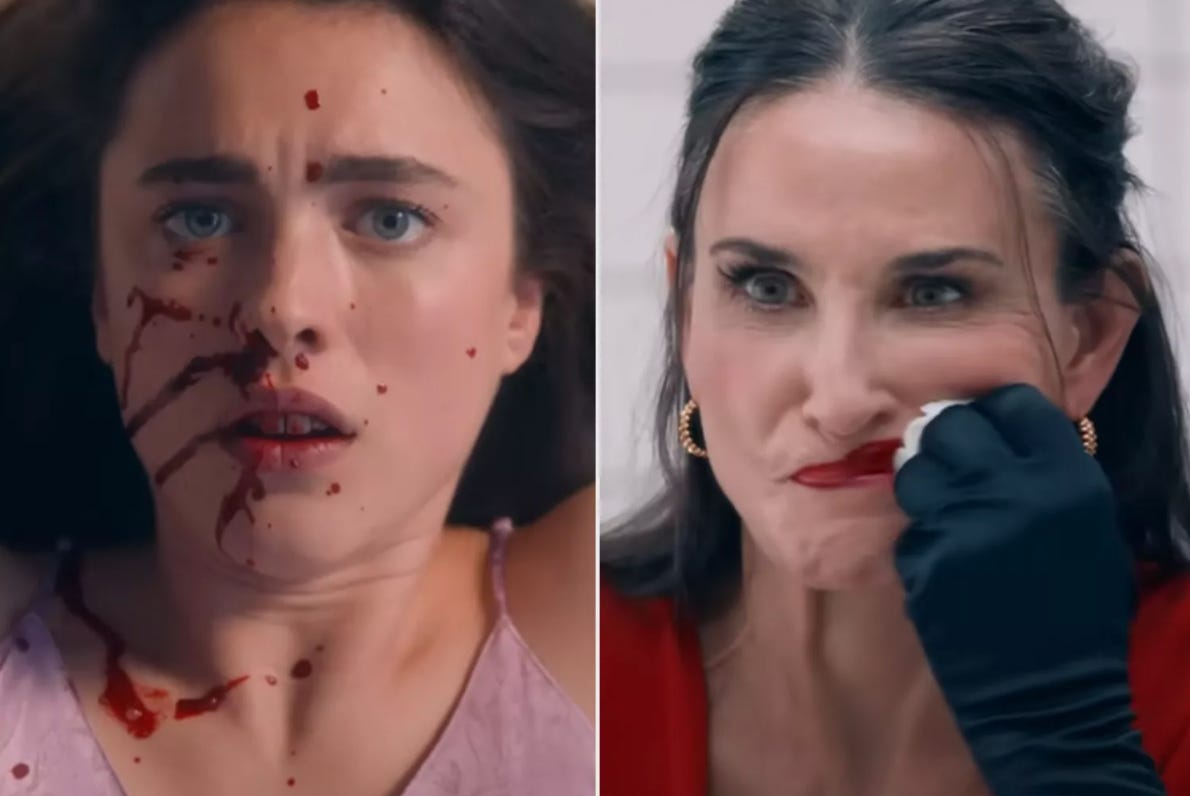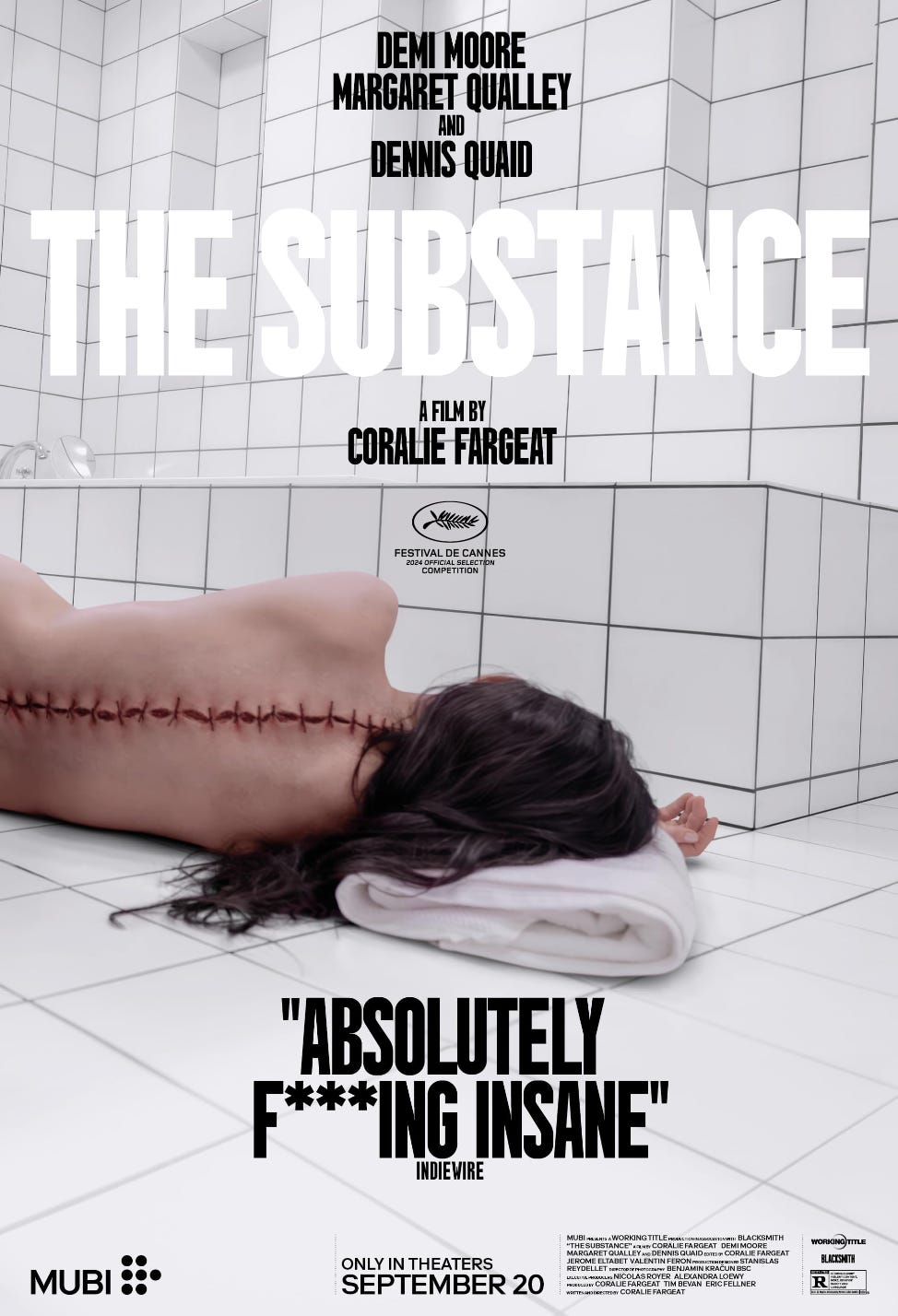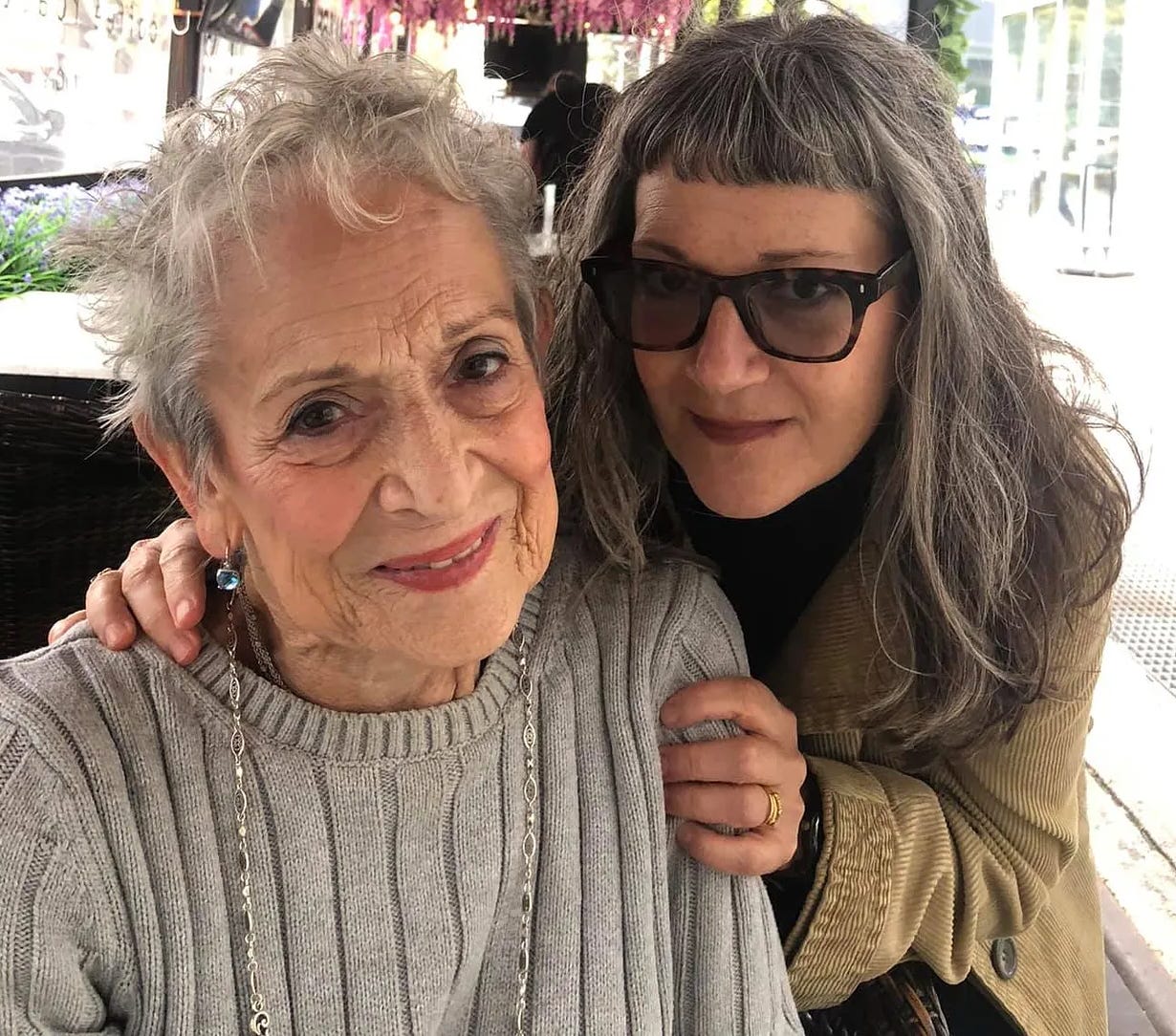On the Path to 60 #2: "At 50 it Stops"
And thank goodness for that. "The Substance" and me.
This is the second installment of On the Path to 60, a series about my experiences in the year approaching my next decade, and the third act of my life. I turned 59 in early October, 2024, and I’ll turn 60 in October, 2025. I’m a little freaked out about it!
In this series I’ll write about what it means for a Gen-X latchkey kid like me to turn 60, from various angles—what I’m thinking and feeling, what’s caught my attention, certain choices I’m making, things I’m buying, advice and guidance I’m receiving, representations of aging in art, and more.
This series is one of two features in Oldster Magazine that are exclusively for paid subscribers. (The other is the Ask the East Village Yenta advice column.) If you’d like to read this series—and support the work I’m doing here at Oldster—please consider becoming a paid subscriber. - Sari Botton
Typically I avoid the hell out of horror movies, but two weeks ago I made an exception. I took myself to a matinee of The Substance, Coralie Fargeat’s dark satire about (I think?) the double-edged sword of gendered ageism and the Faustian bargains it leads some women to make in an effort to keep up with the culture’s ridiculous, punishing beauty standards.
I was surprised by what it brought up for me—probably not what Fargeat intended.
Checking out The Substance felt important given that I’m writing this series about approaching 60. Starring a flawless, remarkably youthful 61-year-old Demi Moore as someone allegedly “over the hill,” the movie underscores (and maybe counter-intuitively reinforces?) limiting cultural attitudes toward women and aging that contribute to my freaking out about my next decade.
Although I can’t say I particularly liked it, the movie got me thinking—surprisingly, in a way that might have begun nibbling away at my fear.
***
A little background on The Substance. Spoilers ahead…
In the film, Moore is pretty convincingly cast 11 years younger than in real life, playing Elisabeth Sparkle, an exercise video megastar who gets fired on her 50th birthday for being too old.
Sparkle’s employer, a cartoonishly diabolical Dennis Quaid, delivers this explanation for her termination: “At 50, well, it stops,” he says, and we’re meant to infer he’s talking about menstruation, and the less enviable changes that take place after it ceases.
Immediately after her humiliating termination, Elisabeth receives an anonymous offer to try an injectable treatment that will allow her to spawn a second, much younger version of herself, with whom she’ll trade places every seven days. Cut to scene of fresh-faced Sue, played by Margaret Qualley, emerging fully formed out of a gash along Elisabeth’s spine.
On their off weeks, Elisabeth and Sue each take turns lying dormant on Elisabeth’s stark, white-tiled bathroom floor, while the other goes about her life. Sue uses her awake time to supplant Elisabeth as the next hot aerobics sensation; Elisabeth uses hers to try to make sense of what the hell is going on, and desperately procuring her next supply of The Substance.
Although Elisabeth is constantly reminded that the two versions of herself “are one,” she and Sue compete with one another. The body horror begins when young Sue starts extending her time in the spotlight past her allotted seven days, leaving middle-aged Elisabeth passed out on the bathroom floor for longer than recommended.
Now, each time Elisabeth awakens days later than intended, another part of her is seen to have aged beyond recognition. It starts with one shriveled, knobby finger, and escalates from there until Elisabeth is unrecognizable—a wizened monster, a freak-show version of a crone. It’s not long before Sue’s body, too, starts behaving strangely—producing weird lumps in the middle of an exercise video shoot, then expelling teeth, chunks of her face, and other body parts, in a frenzy of blood and guts.
***
I had to turn my head a few times, but mostly I found The Substance’s gore to be so over the top—and the narrative so nonsensical—it was comical. I laughed, too, at the notion that someone as well preserved as Moore could be subjected to advanced aging at such lightning speed. The ridiculousness of it all provided the distance I needed from whatever the filmmaker was trying to say (which is not 100% clear to me, nor various critics) to have something of an epiphany:
Sure, aging poses many physical challenges, and it all becomes more difficult the older we get—I can’t argue with that. But thus far, nothing I’ve experienced in mid-life compares to the absolute body horror I endured as a younger woman.
Our culture and this movie seem to be saying that from now on, mostly terrible things lie in store for me. But in my teens, 20s, 30s, and early 40s I suffered in so many ways in that I no longer do—that so many of us past menopause no longer do—and that has made this time in my life a huge relief and joy.
I found myself wondering whether the worst is actually behind me. “At 50 it stops.” Yeah, the horror show of PMS (bloating, acne, breast-tenderness, depression, weeping at AT&T commercials, crippling monthly migraines…) followed by painful cramping and a blood-letting—that stops. Hallelujah.
Sure, aging poses many physical challenges, and it all becomes more difficult the older we get—I can’t argue with that. But thus far, nothing I’ve experienced in mid-life compares to the absolute body horror I endured as a younger woman.
In my case, there were the added nightmares of endometriosis and adenomyosis, which caused murder-scene-level cramping and bleeding, and left me completely wrung out month after month. There were also side-effects from awful hormonal medications I was given to treat those conditions. Oh, were you feeling terrible? Here are some pills that will make you feel even worse—and give you cystic zits in places you didn’t even know you had oil glands, like inside your ear canals.
But the horror began way before that, when I was 11 or so, and I began sprouting breasts. Suddenly there were these tiny, hard little buds protruding from my chest, and they hurt, even when the shower water hit them, or I put on or took off my shirt. What the hell was happening to me, I wondered. (We hadn’t yet been shown Naturally, a Girl, the 1973 short educational film about the changes girls’ bodies go through.)
I walked myself down to the school nurse’s office and told her matter-of-factly, “I think I have breast cancer.” She examined me, then smilingly assured me it was just that I was beginning to “develop.” (You think aging is scary and gross? Try “developing.”)
After I had a hysterectomy at 43, the horror stopped. All of it. That operation and the beginning of menopause gave me my life back after 25 years of horrible suffering. I was set free, released from a relentless cycle of bloating and pain and erratic emotions. It instilled a peace within my body and mind that I never knew I could have.
***
This coincided with another shift: I began to feel less insecure, more confident, not only in who I was—someone with more awareness and knowledge and expertise than before—but also in how I looked. Counter to how we’re told it’s supposed to go, as my 40s progressed, I grew more content with my appearance, especially now that my body was no longer carrying an extra, uncomfortable three to five pounds of bloat for more than half each month.
You think aging is scary and gross? Try “developing.”
I’ve only continued to move in that direction; somehow, I like my looks much more now, at 59, than I did as a young woman. I feel as if I’ve grown into my looks, learned how to work with them. Sure, there are parts I’d trade in if I could, and cellulite I’d love to wake up one morning and discover was missing, but I’ve mostly made peace with all of me. I love my steel gray hair, the way the angles of my face have become more pronounced, even some of the lines that have appeared—they remind me of the chicness of a well-worn pair of old jeans.
I think of it this way—I feel now as if I’m just a different kind of attractive from how I was when I was younger, not less so. I’ve noticed a similar progression in my mother. In her mid-80s she remains as beautiful as ever, and also newly beautiful, in different ways than before.
When I reflect on this mental shift that began in my early 40s and has only continued through my 50s, I realize it stands in opposition to the cultural messaging that’s got me afraid of turning 60 (and which is echoed in The Substance’s garbled message). Maybe, I now reason, given how positively things have gone so far, they won’t be so bad going forward. Maybe my 60s will be good. Maybe I’ll be surprised by other positive developments I can’t yet foresee.
Of course, there’ll no doubt be new aging challenges on the horizon. As time goes on, my joint pain will likely worsen, my memory will falter, I’ll slow down, have less energy. Maybe I’ll lose a tooth or two, or that bridge a dentist installed in 1996. All of that will suck. If I fall ill, that will likely change the calculus, and possibly introduce new kinds of body horror.
But I think to some degree that’s just life, at every phase. All along the timeline, being human is sometimes terrifying and grotesque. For me it was much more so when I was younger.









At 50 it doesn't stop. Fifty, for me, was 40 more evolved and far more interesting. At 60, in 2017, I put on a pink pussy hat and picked up a picket sign for the first time. I felt so grown up, so full of agency, so ME, so US. In two months I'll turn 67, and my first book comes out next spring. If 70 arrives and I'm healthy in body, mind, and spirit, I'll find new metaphorical mountains to climb. You're bold and gorgeous at 59, Sari, as is your mom in her mid-80s. Onward, with verve! 💕
Sari, so glad you've seen the light -- your gorgeousness is undeniable (love the worn-in jeans concept!). I'm trying hard to get where you are when I look in the mirror. I mostly fail. But you're helping. That picture of you and your mom: JUST BEAUTIFUL. Thanks.